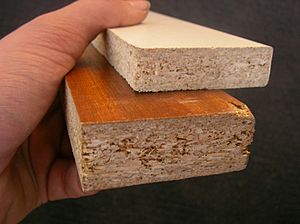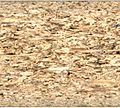Particle board facts for kids
Particle board, also known as chipboard, is a material made from small pieces of wood. Imagine tiny wood chips or sawdust! These wood bits are mixed with special sticky stuff called resin or glue. These sticky materials are also known as adhesives. Then, the mixture is pressed together very tightly with heat. This creates flat, strong sheets.
Particle board is often used to build things like furniture and parts of buildings. It costs less to make than plywood, but it's usually not as strong. There are different types of particle board. One type (Type 1) can swell up if it gets wet. So, it's usually not a good idea to use it outside. Another type (Type 2) uses special glues that can handle water, so you can use it outdoors.
Contents
How Particle Board is Made
Making particle board is like baking a giant wooden cookie! First, small pieces of wood, like chips or sawdust, are collected. These pieces are often leftovers from other wood projects. This helps to reduce waste.
Next, these wood pieces are mixed with a special kind of glue or resin. This sticky mixture is then spread out into a flat layer. Imagine a big, flat sheet of wood chips!
Finally, this layer is put under a lot of pressure and heat. This process presses the wood chips and glue together very tightly. The heat helps the glue to set and become strong. The result is a solid, flat board that can be cut and shaped for many uses.
Why We Use Particle Board
Particle board is a popular material for several reasons:
- Cost-effective: It is usually much cheaper to make than solid wood or even plywood. This makes it a good choice for furniture and building projects where cost is important.
- Uses recycled wood: It often uses wood waste, like sawdust and small chips. This helps to make good use of wood that might otherwise be thrown away.
- Smooth surface: Particle board has a very smooth surface. This makes it easy to cover with things like veneer (a thin layer of real wood), plastic laminate, or paint. This is why you often see it used for kitchen cabinets or shelf units.
- Lightweight: Compared to solid wood, particle board can be lighter, which makes it easier to move and work with.
Types of Particle Board
Not all particle boards are the same! They are made for different uses, especially when it comes to water.
Type 1: Indoor Use
This is the most common type of particle board. It uses glues that are not waterproof. If Type 1 particle board gets wet, it can absorb the water. When it absorbs water, it can swell up and lose its strength. Because of this, Type 1 particle board is best used indoors. You might find it in bedroom furniture, desks, or closet shelves.
Type 2: Outdoor and Wet Areas
Type 2 particle board is made with special glues that are waterproof. This means it can handle moisture much better than Type 1. It won't swell up as easily if it gets wet. This type is more suitable for places where there might be some moisture, like in bathroom cabinets or even some outdoor furniture, as long as it's protected from heavy rain.
Particle Board vs. Plywood
Particle board and plywood are both types of "engineered wood" products. This means they are made by combining wood pieces with adhesives. However, they are made differently and have different strengths.
- Plywood is made from thin layers of wood veneer, glued together with their grain in different directions. This makes plywood very strong and resistant to bending.
- Particle board is made from small chips or sawdust, which are pressed together. This makes it less strong than plywood, especially when it comes to holding screws or resisting heavy weights.
Even though particle board is not as strong as plywood, its lower cost and smooth surface make it a popular choice for many projects.
Related pages
Images for kids




